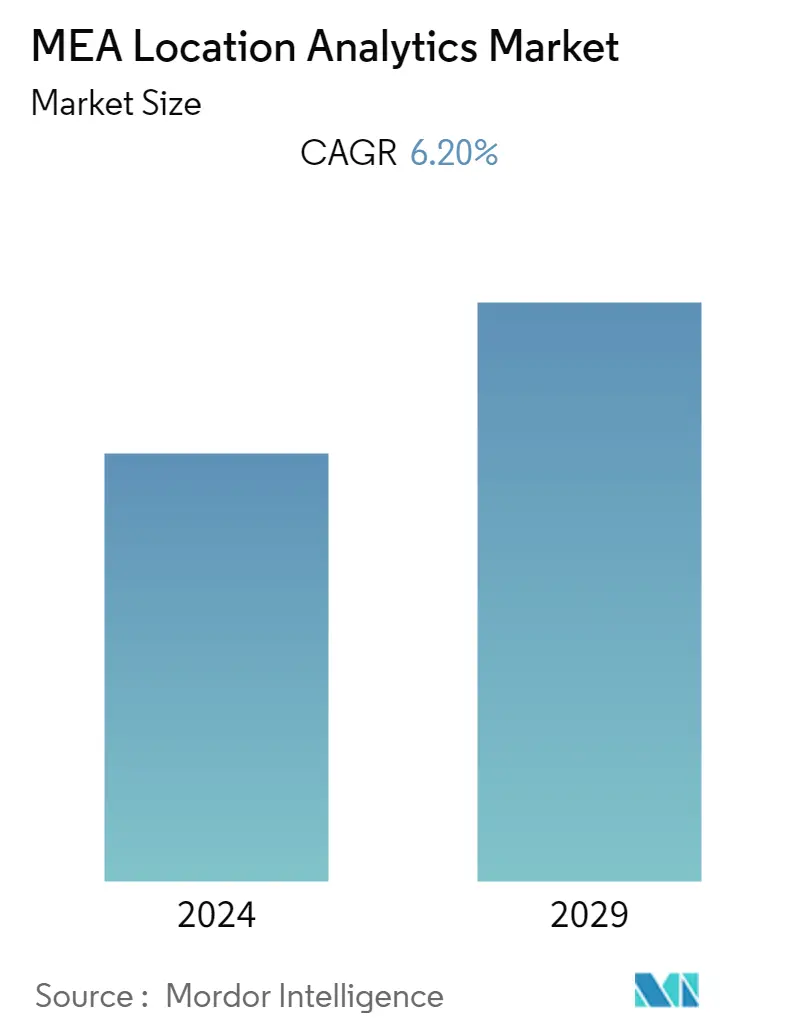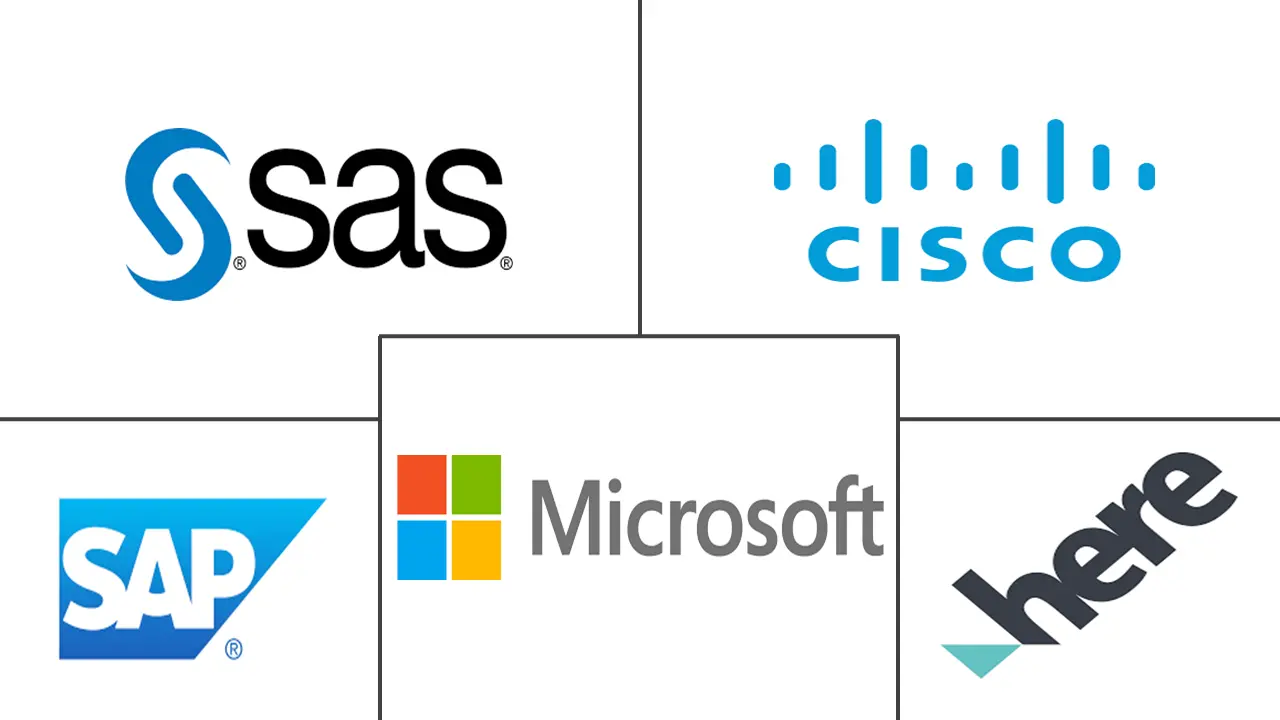
| Study Period | 2019 - 2029 |
| Base Year For Estimation | 2023 |
| Forecast Data Period | 2024 - 2029 |
| Historical Data Period | 2019 - 2022 |
| CAGR | 6.20 % |
| Market Concentration | Low |
Major Players
*Disclaimer: Major Players sorted in no particular order |
Middle East & Africa Location Analytics Market Analysis
The Middle East & African location analytics market will register a CAGR of 6.2% over the forecast period. The growing need for predictive analytics in modern-day business decision-making, consistent innovation in geospatial technologies, and rising usage of spatial data and analytics tools are factors that contribute to the growth of the location analytics market.
- The primary factors driving the growth of the market are the increased use of advanced location intelligence technologies such as Geographic Information System (GIS), Global Positioning System (GPS), and Remote Sensing (RS), as well as technological advancements in business intelligence and geospatial analytical tools, due to the rapid incorporation of location-based mapping technology in business intelligence systems and growing applications of location analytics in disaster management.
- Moreover, emerging technologies are expected to significantly drive the location analytics industry's growth in the coming years. 5G, artificial intelligence (AI), the Internet of Things (IoT), Big Data, and connected sensor devices are advanced technologies that have enabled real-time location data analytics for improved business performance.
- For comprehensive corporate planning, location analytics becomes a powerful analytical tool. New insights are produced by fusing location data with conventional relational data and data from reliable third parties. The Middle East & Africa retail market is starting to focus heavily on location analytics. Every time a customer or consumer enters the store following the last purchase till they leave, a piece of user data is created, and this number of merchants opens up daily.
- Smartphone adoption is exceptionally high in several nations, including the United Arab Emirates and Saudi Arabia. The location analytics market in this area is therefore anticipated to expand quickly. Wi-Fi Location Analysis Systems have been developed due to the expansion of all customer-facing sectors. Due to the system's open communication channels, customers can connect via Wi-Fi in their location, such as shopping malls.
- Consumer privacy considerations are essential when processing location data because numerous regulatory restrictions may make it impossible to get location data without the user's consent. Some geospatial analytics solutions require acquiring necessary location data, which some users may object to if they are concerned about the security of their location-based data.
- Due to the growing usage of location intelligence or analytics to better understand the effects of COVID-19 on consumer behavior and the economy, the COVID-19 outbreak does not affect the expansion of the location analytics business.
Middle East & Africa Location Analytics Industry Segmentation
Location analytics involves collecting and managing customer location data, enriching it with other data sources, and analyzing contextual information to inform optimized customer behavior, decisions, and experiences.
The Middle East & African Location Analytics Market is Segmented by Location (Outdoor and Indoor), Deployment Model (On-premise, On-demand), Application (Remote Monitoring, Asset Management, Facility Management), Component (Software, Services), Verticals (Retail, Manufacturing, Healthcare, Government, Energy and Power, Other Verticals) and Country (United Arab Emirates, Saudi Arabia, Israel). The market sizes and forecasts are provided in terms of value (USD million) for all the above segments.
| Outdoor |
| Indoor |
| On-premise |
| On-demand |
| Remote Monitoring |
| Asset Management |
| Facility Management |
| Software |
| Services |
| Retail |
| Manufacturing |
| Healthcare |
| Government |
| Energy and Power |
| Other Verticals |
| United Arab Emirates |
| Saudi Arabia |
| Israel |
| Other Countries |
MEA Location Analytics Market Size Summary
The Middle East and Africa location analytics market is poised for significant growth, driven by the increasing integration of advanced location intelligence technologies such as GIS, GPS, and remote sensing. These technologies are becoming integral to business intelligence systems, enhancing decision-making processes across various sectors, including retail and disaster management. The market's expansion is further supported by the rapid adoption of emerging technologies like 5G, AI, IoT, and Big Data, which facilitate real-time location data analytics. This trend is particularly evident in countries with high smartphone penetration, such as the United Arab Emirates and Saudi Arabia, where Wi-Fi location analysis systems are being developed to enhance customer engagement in consumer-facing sectors. Despite concerns over consumer privacy and regulatory challenges, the demand for location analytics remains robust, with businesses leveraging these tools to gain insights into consumer behavior and economic trends.
The region's digital transformation is bolstered by government initiatives and strategic plans aimed at enhancing productivity and economic growth through AI and machine learning. Saudi Arabia's Vision 2030 and the UAE's Artificial Intelligence Strategy exemplify the commitment to becoming global hubs for AI and big data. These efforts are supported by advancements in cloud computing, high-speed connectivity, and geospatial analytics, which are reshaping the business landscape. The market is characterized by the presence of major industry players like Cisco, Oracle, SAP, Microsoft, and SAS Institute, who are continuously innovating to meet the region's evolving needs. Recent developments, such as SAS Viya's availability on Microsoft Azure and IBM's new software for data-driven decision-making, highlight the ongoing investment in location analytics technologies. As competition intensifies with the entry of new e-commerce players, the location analytics market in the Middle East and Africa is expected to experience dynamic growth, driven by technological advancements and strategic government policies.
MEA Location Analytics Market Size - Table of Contents
1. MARKET DYNAMICS
-
1.1 Market Drivers
- 1.1.1 Rise of Technological Advances in Various Applications to Witness the Growth
- 1.1.2 Increasing Adoption of Analytical Business Intelligence and Geographical Information Systems technology
- 1.1.3 Increaseing Usage of IoT
-
1.2 Market Restraints
- 1.2.1 Concerns about Security and Privacy
- 1.2.2 Systems are Error Prone in cases like Incomplete Business Information, Out-of-date Information, and Limitation of Place Databases
2. MARKET SEGMENTATION
-
2.1 Location
- 2.1.1 Outdoor
- 2.1.2 Indoor
-
2.2 Deployment Model
- 2.2.1 On-premise
- 2.2.2 On-demand
-
2.3 Application
- 2.3.1 Remote Monitoring
- 2.3.2 Asset Management
- 2.3.3 Facility Management
-
2.4 Component
- 2.4.1 Software
- 2.4.2 Services
-
2.5 Verticals
- 2.5.1 Retail
- 2.5.2 Manufacturing
- 2.5.3 Healthcare
- 2.5.4 Government
- 2.5.5 Energy and Power
- 2.5.6 Other Verticals
-
2.6 Country
- 2.6.1 United Arab Emirates
- 2.6.2 Saudi Arabia
- 2.6.3 Israel
- 2.6.4 Other Countries
Middle East & Africa Location Analytics Market Research FAQs
What is the current MEA Location Analytics Market size?
The MEA Location Analytics Market is projected to register a CAGR of 6.2% during the forecast period (2025-2030)
Who are the key players in MEA Location Analytics Market?
SAS Institute Inc, SAP SE, Cisco Systems, HERE and Microsoft Corporation are the major companies operating in the MEA Location Analytics Market.


